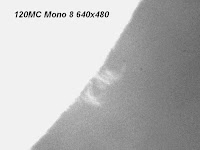*
Thursday 2: Those of you still holding their breath for an update on my HitechAstro DC Focus controller saga will be relieved to know that they can now stop holding their breath. HitechAstro have finally released a new software Suite 1.4.
Software:
Hitec DC Focus - HitecAstro
Product:
HitecDCFocus - HitecAstro
Software:
Hitec DC Focus - HitecAstro
Product:
HitecDCFocus - HitecAstro
Will the new software still terminally crash SharpCap? So that the laptop must be restarted because SharpCap will no longer respond to any key press? Even though you were in the middle of imaging and blogging and processing images.
Of course the moment the computer was restarted and you opened SharpCap, it would instantly crash again. Because you couldn't set it not to talk to HitechAstro's DC SharpCap Planet Destroyer before it crashed. Because [naively] you had trusted the software would actually work and had set HitechAstro to be the focuser controller under Hardware in SharpCap.
In the end I had to uninstall SharpCap and set the newly downloaded version to ignore the presence of the HitechAstro DC Planet Killer. Which meant choosing a simulator for focusing just to be on the safe side. But being a simulator it doesn't actually do anything. It's sort of... "pretend" software.
Oddly, the HitechAstro's painfully small control buttons still worked. So I could still focus with the little Skywatcher [clone] DC gearbox motor. You remember that one? Where the cheap little control box [paddle] buttons died within an hour?
Well, I had adapted the motor to drive my truly excellent Feather Touch 3545 focuser at great personal cost in time and initiative via a belt and timing gears. Doing so without any of the hideous protuberances common to the hellishly expensive commercial drive systems. Though I still had absolutely no control over the speed of the motor it was still useful. You would not believe how short a button press was required to achieve focus. Even on a long focus f/12 refractor!
Well, I had adapted the motor to drive my truly excellent Feather Touch 3545 focuser at great personal cost in time and initiative via a belt and timing gears. Doing so without any of the hideous protuberances common to the hellishly expensive commercial drive systems. Though I still had absolutely no control over the speed of the motor it was still useful. You would not believe how short a button press was required to achieve focus. Even on a long focus f/12 refractor!
I have duly downloaded the new HitechAstro software onto my laptop and will report tomorrow whether it works or destroys the planet as we know it.
Who knows, it might even force AWR-ASCOM to recognise PHD2? Nah, that's never going to happen. Is it?
Did I mention I had to twice reverse the direction of DECLINATION drive in AWR-ASCOM in the last two days? It arbitrarily changed direction without so much as a by your leave. Causing the familiar nose down slew to point at the NE observatory floor. I know I mentioned that AWR-ASCOM won't talk to PHD2. Or was it vice versa? Whatever.
Friday Update: Grey skies but good news: The New HitechAstro software Suite 1.4 worked. First I had to choose HitechDCFocus1 focuser under Files -> Hardware -> Focuser in SharpCap. I tried to run it on the first DCFocus option but SharpCap crashed again!
Get it right and a black control box appears on the screen with lots of really useful speed and distance of travel options. BTW: The blue on black bars are control sliders. Drag the puck along to taste. It is great to be able to see the focuser motor crawling around now.
It all works a treat but I'd prefer a "light" version of the control panel for we sun worshipper/imagers. Nevertheless, I have pinned the black control panel to the taskbar for instant access.
Software:
Hitec DC Focus - HitecAstro
Product:
HitecDCFocus - HitecAstro
Who knows, it might even force AWR-ASCOM to recognise PHD2? Nah, that's never going to happen. Is it?
Did I mention I had to twice reverse the direction of DECLINATION drive in AWR-ASCOM in the last two days? It arbitrarily changed direction without so much as a by your leave. Causing the familiar nose down slew to point at the NE observatory floor. I know I mentioned that AWR-ASCOM won't talk to PHD2. Or was it vice versa? Whatever.
Friday Update: Grey skies but good news: The New HitechAstro software Suite 1.4 worked. First I had to choose HitechDCFocus1 focuser under Files -> Hardware -> Focuser in SharpCap. I tried to run it on the first DCFocus option but SharpCap crashed again!
Get it right and a black control box appears on the screen with lots of really useful speed and distance of travel options. BTW: The blue on black bars are control sliders. Drag the puck along to taste. It is great to be able to see the focuser motor crawling around now.
It all works a treat but I'd prefer a "light" version of the control panel for we sun worshipper/imagers. Nevertheless, I have pinned the black control panel to the taskbar for instant access.
Software:
Hitec DC Focus - HitecAstro
Product:
HitecDCFocus - HitecAstro
*


































